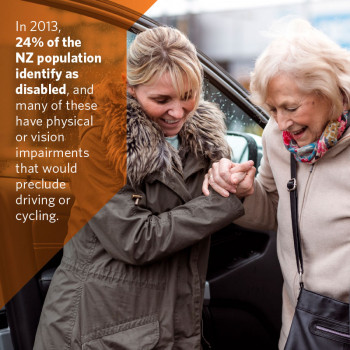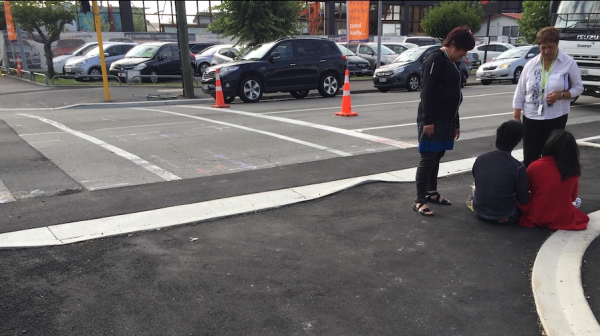 Equity means that the benefits of investment in transport are distributed such that all people are able to participate in society.[1]
Equity means that the benefits of investment in transport are distributed such that all people are able to participate in society.[1]
Providing for pedestrians is crucial for disabled people who do not have access to other travel modes, or those who rely on walking to access other travel modes such as public transport:
The New Zealand Disability Action Plan 2019-2023 includes eight outcomes: education, employment and economic security, health and wellbeing, rights protection and justice, accessibility, attitudes, choice and control, and leadership.[4] Being able to get around by walking is integral to all these outcomes.
Equity also means proactively ensuring that people who have historically had fewer transport choices (women caring for children in single car households, children and elderly people who cannot drive, and people who cannot afford other modes) can still get where they need to go on foot. As an example, equitable provision of a walking facility may require consideration of personal security as this may impact a woman’s travel choice.
The Road to Zero Strategy[5] states:
Ceasing or reducing driving in older age can lead to social isolation. Older people undertake a greater proportion of their overall travel by walking, so it is important to ensure our roads and roadsides are safe for everyone, including those with balance challenges, or visual or cognitive decline.
The Better Later Life Strategy[6] also emphasises that making it easier to walk and cycle to everyday destinations supports the physical and mental wellbeing of older people.
See Pedestrian planning principles for more information on people who depend on walking for mobility. See the 'Design' sections of this guidance for more information on “universal design”, and best-practice external documents such as the Auckland Council’s Universal Design Tool.
PNG: Pedestrian planning principles
Universal Design Tool (Auckland City Council)(external link)
The images below illustrate a poor outcome for walking that could have been avoided through better design, and a good outcome for pedestrians by providing a well designed bus stop with an accessible kerb height.

A kerb upstand caused a tourist trip injury.

A well-designed bus stop with accessible kerb height.
[1] Victoria Transport Policy Institute. (2019). Evaluating Transportation Equity: Guidance For Incorporating Distributional Impacts in Transportation Planning(external link). Accessed 20 January 2020
[2] Ministry of Transport. (2018) Household Travel Survey 2015-2018(external link). Accessed 20 January 2020
[3] Statistics New Zealand. (2013). Disability Survey(external link). Accessed 20 January 2020
[4] Office for Disability Issues. (2019). Disability Action Plan 2019-2023(external link). Accessed 20 January 2020
[5] Ministry of Transport. Road to Zero(external link)
[6] Ministry of Social Development. (2019). Better Later Life He Oranga Kaumātua 2019 to 2034 (DRAFT)(external link)